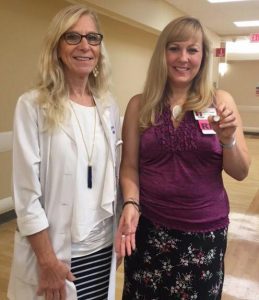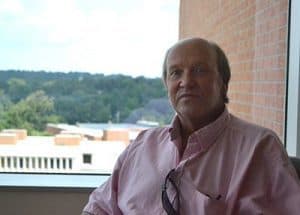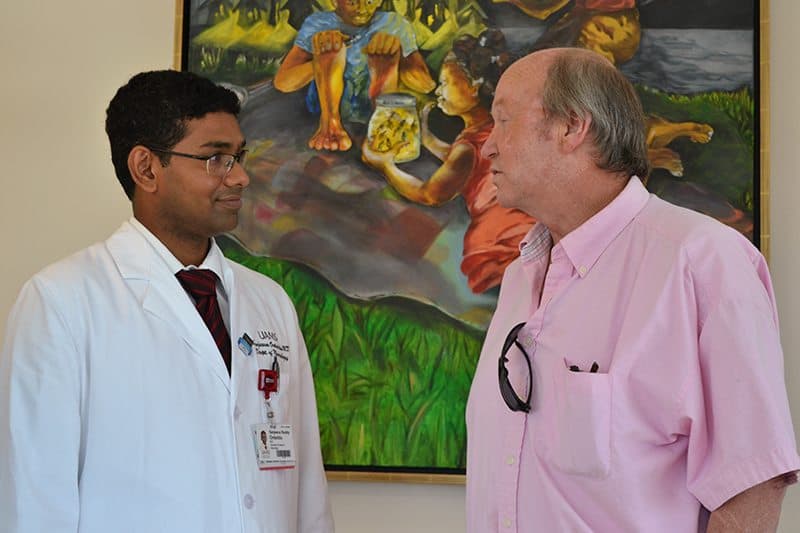UAMS Nurses Spring into Action after Visitor Has Stroke
| Aug. 23, 2016 | In the blink of an eye, Ricky Mays went from caregiver to patient.
For two weeks in May, the Hot Springs man had been staying at UAMS with a friend who was recovering from a spine operation. Then on May 15, the 54-year-old Mays collapsed while giving his friend a pillow.

Tim Trusty, R.N., (center) and Carol Harris, R.N., were awarded “I Saved a Brain” pins by Sanjeeva Onteddu, M.D., for quickly getting Ricky Mays helps after he suffered a stroke.
“I remember falling down and trying to get back up. That is the last I remember,” he said, adding that his friend thought he was having a seizure.
Nurses who answered the call for help found Mays unable to move his right side or speak — classic signs of a stroke. They quickly grabbed a wheelchair and escorted Mays to the Emergency Department (ED), where they activated the stroke pager, which brought experts in stroke care running to Mays’ bedside.
“When we saw that Mr. Mays was having a stroke, we knew that we had a short window for him to get help to minimize his symptoms,” said Carol Harris, R.N., who was the charge nurse on the eighth floor’s H wing that day.

Debra Johnson, R.N., awards Marine Oates, R.N., an “I Saved a Brain” pin for her actions in getting Ricky Mays help after he had a stroke while visiting a UAMS patient.
Three nurses on H8 — Harris, Martine Oates, R.N., and Tim Trusty, R.N. — were awarded “I Saved a Brain” pins for their quick actions in recognizing that Mays was having a stroke and getting him immediate help.
Mays was treated by Sanjeeva Onteddu, M.D., an assistant professor of neurology in the College of Medicine and medical director of AR SAVES.
Onteddu said Mays received clot-busting medication (Activase) within 40 minutes of his arrival in the ED. A CT angiogram showed significant blockage of a big blood vessel inside the brain on his left side, so physicians went did an advance endovascular clot retrieval procedure.
Speed matters when it comes to strokes, Onteddu said. Clot-busting medications need to be given within three hours of the stroke for maximum effectiveness, he said. Advanced stroke procedures are best performed in the first six hours after a stroke.
“The sooner we do any treatment, the better the patient’s outcome,” he said.
Both Harris and Onteddu said they’ve never had a visitor have a stroke on H8, which ironically is the floor where UAMS treats stroke patients.

Ricky Mays says he is grateful for the doctors and nurses at UAMS. “God was certainly looking out for me.”
“Mays was in the right time and right place,” said Onteddu. “Everything got done so fast, that is why he is doing so well.”
For Mays, that quick treatment means he has few lasting effects from his stroke. He said he has difficulty writing with his right hand and is undergoing occupational therapy to help with that. He also has a small limp.
“I’m thankful for the doctors and nurses. I’m glad I was here, real glad,” he said. “God works miracles. I know I wouldn’t be where I’m at, the way I am now, if I hadn’t been at UAMS when I had the stroke. God was certainly looking out for me.”
He added that this is the second time that nurses and physicians at UAMS have saved his life. In 2005, he was medflighted to UAMS from Pine Bluff after a car crashed into his house. He spent 38 days in the hospital recovering from his injuries.
